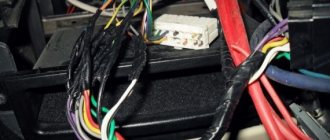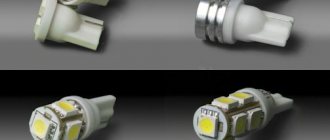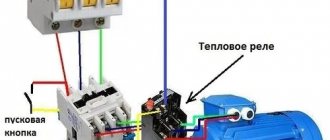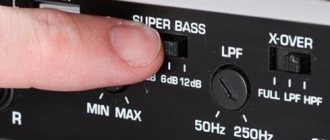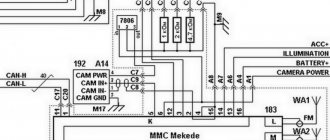Connecting a subwoofer 2 X 2
Low-frequency systems with two loudspeakers are often installed in cars.
They provide great power, deep and rich bass. The connection diagram for a 2 X 2 subwoofer may differ from other options. This design can be made in the form of a closed box or work with a bass reflex. Connecting a 2 X 2 subwoofer can be done in two simple ways. This is a series or parallel connection of loudspeaker voice coils. In order to calculate the resulting resistance, a simple formula is used. The voice coil winding is a low-resistance resistor. When two 2 Ohm coils are connected in series, the total resistance is 4 Ohms, based on the formula R total = R1 R2 or 2 Ω 2 Ω = 4 Ω.
https://www.youtube.com/watch?v=ytcopyrightru
The connection diagram for a 2 X 2 subwoofer at 4 Ohms does not cause any difficulties, since almost all low-frequency amplifiers operate with such a load. The formula for parallel connection of resistances looks a little different. Here the resulting resistance of several resistors will be less than the smallest resistance of the parallel circuit.
According to the formula Rtotal=R1*R2/R1 R2, the resistance of two 2 Ω coils connected in parallel will be equal to 1 Ω. Connecting a 2 X 2 in 1 subwoofer is associated with some difficulties, since not all models of low-frequency amplifiers can work correctly with such a load impedance. Each connection has its own specifics.
If in the subwoofer connection diagram there are 2 X 2, the windings of the voice coils are connected in series, then the power will decrease by about half. Since one speaker with an impedance of 2 provides a nominal power of 500 watts, connecting a second speaker in parallel with the same impedance will reduce the system output power to 350 watts.
The 1 Ohm subwoofer connection circuit is not used often, since, despite the high output power, this mode does not provide good quality reproduction of low frequencies. Some models of low-frequency car amplifiers do not allow the connection of such a small load at all. Connecting two 1 Ohm subwoofers is allowed only with a series connection of the windings.
A resistance of 0.5 Ω, which is obtained with a parallel connection, can destroy the amplifier. A bridge switching circuit will reduce this value by another factor of two. When connecting a 1 Ohm subwoofer, you need to remember that as the resistance decreases, the current increases, so all connecting cables must have the appropriate cross-section. Do not use single-core wires or cables intended for electrical wiring to connect high-power speaker systems.
Subwoofer connection 1 1
The 1 Ohm subwoofer connection circuit is not used often, since, despite the high output power, this mode does not provide good quality reproduction of low frequencies. Some models of low-frequency car amplifiers do not allow the connection of such a small load at all. Connecting two 1 Ohm subwoofers is only allowed when the windings are connected in series. A resistance of 0.5 Ω, which is obtained with a parallel connection, can destroy the amplifier. A bridge switching circuit will reduce this value by another factor of two. When connecting a 1 Ohm subwoofer, you need to remember that as the resistance decreases, the current increases, so all connecting cables must have the appropriate cross-section. Do not use single-core wires or cables intended for electrical wiring to connect high-power speaker systems.
How to connect a 4 ohm sub
Connecting a subwoofer at 4 is considered the most common, since most dynamic heads have such resistance, and all types of low-frequency amplifiers allow the use of such speakers as a load. You can organize a 4 ohm load using two 2 ohm speakers connected in series, when the plus of one speaker is connected to the minus of the other.
The connection diagram for a subwoofer in 4 can be obtained using a two-winding speaker. Depending on their resistance, the connection configuration depends. Two coils of 8 connected in parallel will give, as a result, the required 4 Ohms. The same resistance is obtained if two voice coils with a resistance of 2 ohms are connected in series.
In the connection diagram for a subwoofer in 4, the minus of one voice coil is connected to the plus of the other winding, and the remaining free contacts are connected to the output of the low-frequency amplifier, observing polarity. Connecting two subwoofers of 4 is carried out in parallel or in series. Connecting a subwoofer 4 4 in 2 will provide increased power almost twice. The series resistance of the windings will be 8 Ω. The power will be reduced, but the bass performance will be bright and clear.
The connection diagram for a 2 Ohm subwoofer is carried out according to the classical scheme, when the speaker coil is connected to a low-frequency amplifier. It is better to connect a 2 Ω subwoofer, consisting of one loudspeaker, to a separate ULF channel, since when bridged, the low resistance of the coil can damage the system.
In addition to a subwoofer with one speaker, a system of two separate 2 Ohm loudspeakers or a two-winding dynamic head can be used as a ULF load. By combining the connection of the voice coils you can connect a 2 2 in 4 ohm subwoofer. To do this, they need to be connected in series. Connecting 2 x subwoofers 2 2 is carried out with a large-section multi-core acoustic cable to avoid power losses due to heating of the connections. In order to connect two 1 ohm subwoofers, the 2 ohm voice coils must be connected in parallel.
How to connect two subwoofers to one monoblock
An acoustic low-frequency system can consist of one or two speakers. Columns in which a larger number of loudspeakers are installed are used extremely rarely due to their large dimensions. The following amplification systems can be used to organize a low-frequency channel:
- Monoblock
- Two channel amplifier
- Four-channel ULF
A monoblock is a separate amplifier that works only on the low-frequency channel. The connection diagram for two subwoofers to a monoblock depends on the resistance of the voice coil winding. If it is equal to 4 Ohms, then both parallel and series connections of windings are allowed. As a result, the total resistance of the speaker system can be 2 Ohms or 8 Ohms. Connecting a subwoofer 8 Provides the highest quality bass reproduction with a minimum of non-linear distortion. This configuration is the safest for a low-frequency unit, since the currents in the amplifier circuits will be small and the elements of the output stages will not overheat. You can connect 2 subwoofers with speakers of 2 Ohms each to the monoblock. In this option, only a serial connection is allowed if the car uses an AB class amplifier. If the basis of the low-frequency system is ULF class D, then parallel connection of loudspeakers with a total resistance of 1 ohm is allowed.
In addition to speaker systems with two speakers, speakers with two windings are often used in low-frequency channels. Typically, such heads have a winding resistance of 2, 4 or 8 ohms. You can connect a two-coil subwoofer to a monoblock, as well as separate speakers, in several ways. Since there are two coils, their separate connection to the monoblock is impossible. To do this, you need to use a two-channel or four-channel amplifier. The connection diagram for a 2 X 2 Omak monoblock subwoofer allows parallel connection of windings for ULF class D and only serial connection for other classes of amplifier equipment. The most common mistake when connecting a 2 X 2 sub is using only one winding. Some people believe that there is only one channel in a monoblock and it is enough to connect only one winding. Testing of speakers with two coils and different connection schemes showed that when only one coil is connected to the output of a low-frequency amplifier, the sensitivity of the speaker system decreases by approximately 3 dB. Therefore, you can connect a subwoofer to a monoblock only by connecting both windings.
How to connect a two-coil subwoofer
Connection diagrams for a two-coil subwoofer are limited to the following several options:
- Parallel connection
- Serial connection
- Separate connection
Most often, the resistance of the windings of low-frequency speakers is 2 or 4 ohms. With a parallel connection, the total resistance will be half the resistance of each winding. It will be 1 or 2 respectively. A series connection will give a resistance of 4 or 8 Ω. By reducing the output power, the best sound quality is achieved at low frequencies.
In addition, you can connect a subwoofer with two coils without connecting them, but by using each winding for a separate channel of the low-frequency amplifier. Connecting 2 coil subwoofers must be done with strict observance of polarity. It would be undesirable for an amplifier to connect a 2 Ohm subwoofer in a bridge connection.
Each amplifier channel will operate at 1 Ω, and this is a dangerous load for some models of low-frequency equipment. The power will increase, but at the same time the current will increase and nonlinear distortion will increase. The ULF output stages will operate in a critical mode and may fail. Separate connections are allowed only if absolutely the same signal is supplied to both channels of the amplifier.
How to connect a subwoofer to an amplifier
Single channel connection
Connecting a subwoofer to an amplifier is not difficult; just connect the amplifier's audio output jack to the subwoofer coil or coils using speaker wires.
The wires should not be thin. In most cases, choose copper wiring with a cross-section of 4 mm and there will be no problems.
Connecting speaker wires
This subwoofer connection diagram is suitable for one channel of an amplifier or monoblock.
- How to connect a subwoofer to a music center
Monoblock is a single-channel amplifier designed specifically for subwoofers.
Connecting to a subwoofer via terminal block
Connecting to a subwoofer directly
Connecting a subwoofer with a bridge
In the case of using a multi-channel amplifier, the sub can be connected to two channels simultaneously, using the minus of one and the plus of the other, this connection is called bridged, with this method the power output by the amplifier increases significantly (see the specifications for specific numbers).
So you can connect a subwoofer to a two or four channel amplifier, using 2 channels for acoustics, and the remaining 2 for the subwoofer.
To connect a subwoofer with a bridge, make sure that your amplifier supports this feature.
If you connect a low-frequency speaker to an amplifier by changing the polarity, that is, connect the plus of the subwoofer to the minus of the amplifier output and vice versa, then the speaker will work in antiphase, there is nothing wrong with that, sometimes such a connection is used intentionally if the amplifier does not have phase adjustment (more about adjustment phases).
- Connecting an active subwoofer to an amplifier via a high-level input
Connecting the subwoofer coils
The technical documentation for the subwoofer states the resistance of its coils (1 Ohm, 2 Ohm, 4 Ohm, rarely 0.5 Ohm), and the technical documentation for the amplifier indicates what resistance it can work with, this information is needed so that you connect correctly and effectively subwoofer to amplifier. The lower the resistance of the sub, the more power the amplifier will produce, provided that it can operate at this resistance. A subwoofer speaker may have several coils (1 or 2, rarely 4).
When the coils are connected in series, the resistance increases, while in parallel it decreases. If you don't want to learn definitions and count fractions, just save this cheat sheet (parallel and serial connections).
Connection options
How much ohm to connect the subwoofer
The higher the resistance, the better the sound quality; the lower, the more power the amplifier delivers. If you need a lot of loud bass, then turn it to the minimum that the amplifier can provide, and if the overall sound quality of the system comes first, then it is 2 Ohms or 4 Ohms, depending on the power output.
Video on how to connect 2 subwoofers or more. Subwoofer connection diagram 2x2 Ohm, 4x4 Ohm, 1x1 Ohm. Serial connection of speakers. Parallel connection of speakers. Basic principles.
Happy connections!
FAQ - Connecting car subwoofers with two coils | Topic author: Diamanda
Connecting car subwoofers with two coils
Speakers with a double voice coil are still the same electrodynamic type heads, and in appearance they are not much different from their analogues with a single voice coil.
They can only be “calculated” by an additional pair of terminals for connecting a power amplifier. However, this pair of terminals is already a consequence of technology, and the reason is the presence of an independent additional wire, which is wound onto the voice coil frame on top of the standard winding. Typically, both of these conductors are made of the same material and have an identical number of turns with similar electrical characteristics.
It is clear that the introduction of additional winding increases the cost of the subwoofer design. But, paradoxically, this does not lead to a clear gain, and according to criteria such as characteristic sensitivity, efficiency, etc., such subwoofers may well lose to traditional ones.
So why are dual voice coil designs, or more accurately dual winding, so popular?
A two-coil subwoofer, as well as two, three or more subwoofers, can be connected in four ways:
Parallel connection of subwoofer coils
There are three types of coil connections: Parallel, Series and Combined.
What happens when coils are connected in parallel or in series. When the coils are connected in parallel, the total resistance, roughly speaking, becomes half as much. For example: if we connect two 4 Ohm coils in parallel, we get a total resistance of 2 Ohms, if we connect two 2 Ohm coils, we get a total resistance of 1 Ohm. The opposite effect occurs with a series connection. When connecting two 4 Ohm coils in series, we get a resistance of 8 Ohms, when connecting two 2 Ohm coils, we get 4 Ohms. etc.
Parallel connection of coils 1/R=1/R1+1/R2+…1/Rn As described above, with a parallel connection, the resistance is halved, which allows the amplifier, operating with a lower load, to produce more power. But as they say, “if it leaves somewhere, it will definitely arrive somewhere.” In this case, this is true, only on the contrary, the power has increased, and the amplifier’s control over the subwoofer has decreased, as a result of which the bass becomes smeared.
Series connection of coils. R=R1+R2+…+Rn If the amplifier is powerful, why not, increase the impedance (resistance) and get a more developed bass. I would also like to add that if the resistance of the connected coils exceeds the permissible load of the amplifier, this is not at all scary, it’s just that the output power of the amplifier will be less. Let's say an amplifier with a declared operation for a load of 4 ohms produces 500 watts, and with a load of 8 ohms, for example, it will produce 350 watts. Combined connection. Subwoofers are coils that are simultaneously connected in serial and parallel connections for switching to a specific load. There are a great many connection options, it all depends on the number of subwoofer speakers, the resistance of the subwoofer voice coils and the capabilities of the amplifier.
What could be easier than connecting a single-coil subwoofer to a monoblock or multi-channel amplifier. It's a completely different matter if the subwoofer has two voice coils or two or more of them. A two-coil subwoofer, as well as two, three or more subwoofers, can be connected in four ways: each coil separately, parallel connection of coils, serial and combined. What each of these subwoofer switching options gives is, first of all, versatility, different capabilities. Let's consider each option separately. But first of all, you need to understand what happens when the coils are connected in parallel or in series. When the coils are connected in parallel, the total resistance, roughly speaking, becomes half as much. For example: if we connect two 4 Ohm coils in parallel, we get a total resistance of 2 Ohms, if we connect two 2 Ohm coils, we get a total resistance of 1 Ohm.

